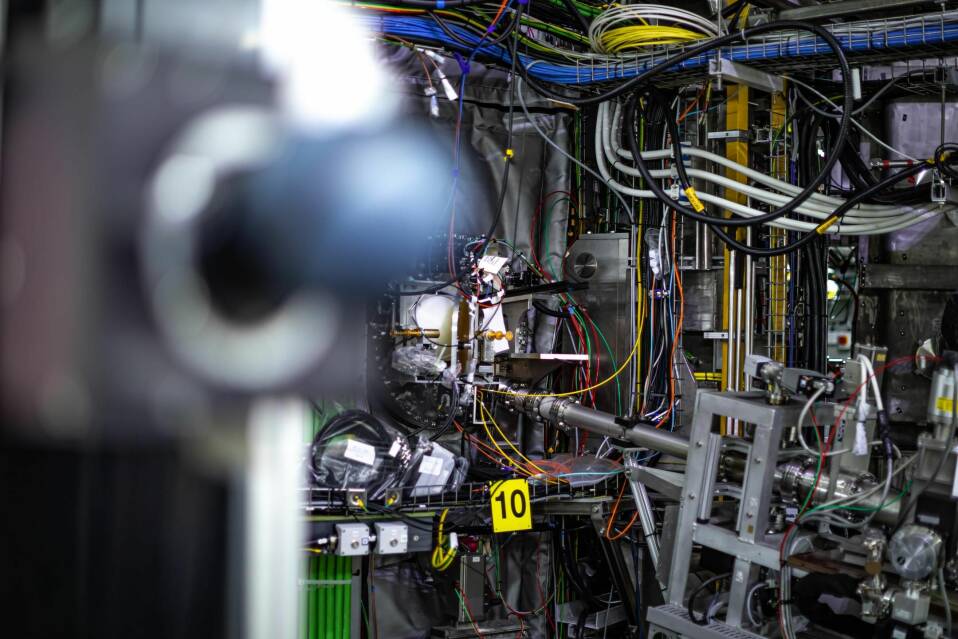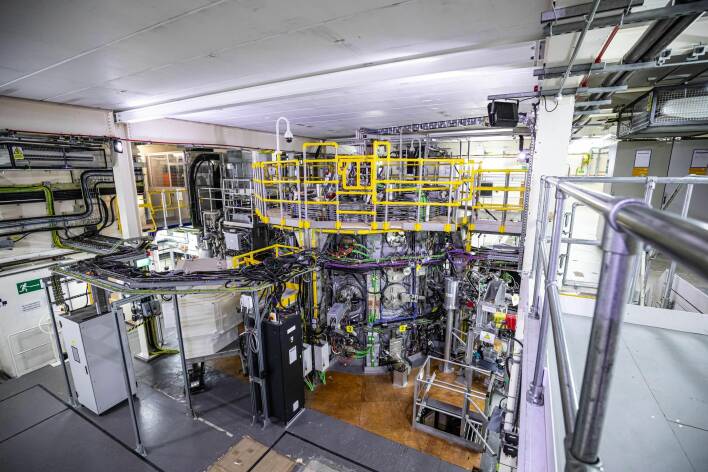
The data captured from previous experiments contributes to the international fusion effort – harnessing the power of the stars here on earth to provide an endless supply of low carbon energy. On a global scale, MAST Upgrade plays a central role in fusion research, providing a vital facility for international scientists to carry out research into spherical tokamaks. MAST Upgrade is one of five tokamaks in the EUROfusion Tokamak Exploitation programme and hosts plasma scientists from across the world. A spherical tokamak is one of several machine designs and its main benefit is that the plasma sits closer to the centre of the machine, where the toroidal field is higher for a given current down the centre of the machine. The result of this is the more efficient use of the magnetic field and the potential for improved plasma confinement. However, as spherical tokamaks are more compact, safely exhausting the heat from the centre of the plasma is
Exciting research continues at UKAEA with MAST Upgrade (Mega Amp Spherical Tokamak), the UK’s flagship fusion experiment. Our unique machine is studying some of the key physics challenges which remain. Based at Culham Campus, this ambitious project keeps the UK at the forefront of global research in our quest for a sustainable and low carbon energy.
MAST Upgrade was constructed between 2013 and 2020, building on a previous tokamak called MAST which operated from 2000 to 2013 and provided valuable insights into plasma physics and fusion technology. As the name suggests, MAST Upgrade is an upgraded machine with enhanced capabilities, including higher plasma performance, longer pulses, and a stronger magnetic field.
more challenging, which motivates our studies of the Super-X.
In the UK, MAST Upgrade is the cornerstone of fusion research. With unique capabilities and advanced diagnostics, it’s providing the UK with a world-class facility to study fusion plasmas and develop the hands-on experience to push the boundaries of fusion research.
The road ahead for MAST Upgrade is an exciting one, potentially full of ground-breaking milestones and achievements. The team is currently preparing for it to begin its next endeavour, with a round of experiments aiming to take us a step closer to the dream of commercial fusion energy. The team is also preparing for some novel improvements to the machine, such as a new heating system which will increase power by 1.6MW and doubling of the neutral beam power. The upcoming and future experiments on MAST Upgrade will be vital in providing experimental data to support crucial decisions for the next fleet of fusion machines.
For more information on MAST Upgrade please visit our website: MAST Upgrade - Culham Campus
One of the key challenges MAST Upgrade focuses on is understanding and reducing the heat coming out of a super-hot plasma. Tackling the plasma exhaust, as it’s called, is crucial for achieving commercial fusion power. What makes MAST Upgrade particularly unique is that it’s the first tokamak in the world to use a highly optimised Super-X divertor. This is an advanced exhaust system, originally developed by the Institute for Fusion Studies at the University of Texas, designed to handle the intense heat from particles leaving the plasma within the main vessel of the machine. Previous experiments on MAST Upgrade have shown to reduce this heat load on the parts of the divertor by a factor of ten, having no impact on the hot fusion core! This is the novel part. It’s important because economically competitive fusion power plants need to maintain good fusion performance while safely exhausting the heat and fuel from the hot fusion core. Compromising on either of these would likely increase the size and cost of a fusion power plant and reduce the machines availability in order to replace damaged components. These benefits of the Super-X were accurately predicted by simulations performed when MAST Upgrade was being designed and constructed, demonstrating that similar tools can be used to design divertors in future fusion machines.
Of course, this is just one aspect of MAST Upgrade’s work. Since 2020, the machine has delivered three scientific campaigns, enabling scientists and engineers alike to improve knowledge of fusion plasmas and how to control them, and increase working knowledge of operating a physical tokamak. This allows those working on MAST Upgrade to gain unique skills and capture invaluable knowledge to transfer to and train the next generation who will design and operate future tokamaks.

For more information on MAST Upgrade please visit our website: MAST Upgrade - Culham Campus
power by 1.6MW and doubling of the neutral beam power. The upcoming and future experiments on MAST Upgrade will be vital in providing experimental data to support crucial decisions for the next fleet of fusion machines.
The data captured from previous experiments contributes to the international fusion effort – harnessing the power of the stars here on earth to provide an endless supply of low carbon energy. On a global scale, MAST Upgrade plays a central role in fusion research, providing a vital facility for international scientists to carry out research into spherical tokamaks. MAST Upgrade is one of five tokamaks in the EUROfusion Tokamak Exploitation programme and hosts plasma scientists from across the world. A spherical tokamak is one of several machine designs and its main benefit is that the plasma sits closer to the centre of the machine, where the toroidal field is higher for a given current down the centre of the machine. The result of this is the more efficient use of the magnetic field and the potential for improved plasma confinement. However, as spherical tokamaks are more compact, safely exhausting the heat from the centre of the plasma is

One of the key challenges MAST Upgrade focuses on is understanding and reducing the heat coming out of a super-hot plasma. Tackling the plasma exhaust, as it’s called, is crucial for achieving commercial fusion power. What makes MAST Upgrade particularly unique is that it’s the first tokamak in the world to use a highly optimised Super-X divertor. This is an advanced exhaust system, originally developed by the Institute for Fusion Studies at the University of Texas, designed to handle the intense heat from particles leaving the plasma within the main vessel of the machine. Previous experiments on MAST Upgrade have shown to reduce this heat load on the parts of the divertor by a factor of ten, having no impact on the hot fusion core! This is the novel part. It’s important because economically competitive fusion power plants need to maintain good fusion performance while safely exhausting the heat and fuel from the hot fusion core. Compromising on either of these would likely increase the size and cost of a fusion power plant and reduce the machines availability in order to replace damaged components. These benefits of the Super-X were accurately predicted by simulations performed when MAST Upgrade was being designed and constructed, demonstrating that similar tools can be used to design divertors in future fusion machines.
Of course, this is just one aspect of MAST Upgrade’s work. Since 2020, the machine has delivered three scientific campaigns, enabling scientists and engineers alike to improve knowledge of fusion plasmas and how to control them, and increase working knowledge of operating a physical tokamak. This allows those working on MAST Upgrade to gain unique skills and capture invaluable knowledge to transfer to and train the next generation who will design and operate future tokamaks.
Exciting research continues at UKAEA with MAST Upgrade (Mega Amp Spherical Tokamak), the UK’s flagship fusion experiment. Our unique machine is studying some of the key physics challenges which remain. Based at Culham Campus, this ambitious project keeps the UK at the forefront of global research in our quest for a sustainable and low carbon energy.
MAST Upgrade was constructed between 2013 and 2020, building on a previous tokamak called MAST which operated from 2000 to 2013 and provided valuable insights into plasma physics and fusion technology. As the name suggests, MAST Upgrade is an upgraded machine with enhanced capabilities, including higher plasma performance, longer pulses, and a stronger magnetic field.
